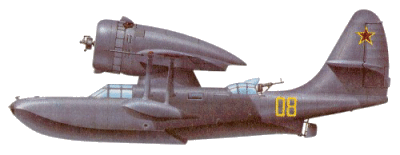More or less in
parallel with the construction and development of the KOR-1 floatplane,
the Beriev bureau was working on the design of a small flying-boat.
This was intended to fulfil the same requirement as the hastily
developed KOR-1, but was intended to provide much improved performance.

First flown in 1940,
this new and basically attractive flying-boat was of all-metal
construction. The term 'basically attractive' is used judiciously, for
without its wing-mounted powerplant this new aircraft had superb lines.
The giant engine, however, rather like the disfigurement of a
hunchback, dominated all else to spoil the aesthetic lines of Beriev's
design. In configuration the Beriev KOR-2, as the new aircraft was
designated, was a parasol-wing monoplane, the wing itself being
pylon-mounted above the stepped flying-boat hull, and braced by two
streamlined struts on each side. An unusual feature was the selection
of an inverted gull wing, but almost certainly this was chosen to raise
the wing-mounted engine as high as possible to provide adequate
clearance for the three-bladed controllable-pitch propeller and, at the
same time, to ensure that the mounting struts for the underwing
stabilising floats could be kept as short as possible. The tail unit
was similar in configuration to that of the KOR-1, except that the high
mounted tailplane was a strut-free cantilever structure.

Designer General Georgij Mikhailovich Beriev
Built in a factory at
Taganrog, on the shore of the almost enclosed Sea of Azov, only a small
number of these aircraft had been completed and delivered to the Soviet
navy before the Taganrog area was over-run by the invading Germans in
the autumn of 1941. Production of the KOR-2, or Beriev Be-4 as it had
then been redesignated, was resumed at a Central Asian factory during
1942, but no records of the number constructed have so far been
discovered.
Specifications (Beriev
KOR-2 or Be-4)
Type: Two Seat
Reconnaissance Flying Boat
Design: Designer
General Georgij Mikhailovich Beriev
Manufacturer:
State Industries Beriev Factory at Taganrog
Powerplant: One
900 hp (671 kW) Shvetsov M-62 9-cylinder radial engine.
Performance:
Maximum speed 223 mph (360 km/h); service ceiling 26,575 ft (8100 m)
Range: 590 miles
(950 km) on internal fuel.
Weight: Empty
equipped 4,530 lbs (2055 kg) with a maximum take-off weight of 6,085
lbs (2760 kg).
Dimensions: Span
39 ft 4 1/2 in (12.00 m); length 34 ft 5 1/4 in (10.50 m); height 13 ft
3 in (4.05 m); wing area 274.5 sq ft (25.5 sq m).
Armament: One
7.62 mm (0.30 in) ShKAS machine-gun on a flexible mount in aft cockpit,
plus up to 661 lbs (300 kg) of bombs or depth charges on underwing
racks.
Variants: Beriev
KOR-2 or Be-4.
Avionics: None.
History: First
flight 1940.
Operators:
Soviet Union (VVS-VMF).
